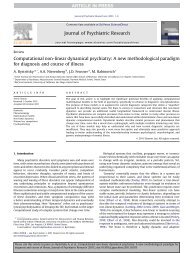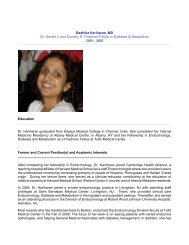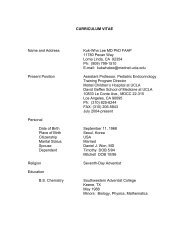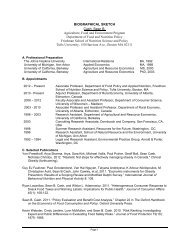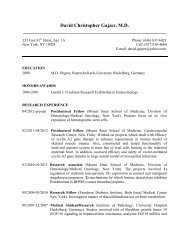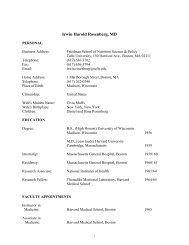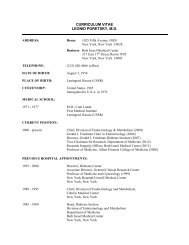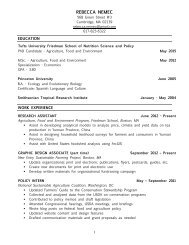Leukopenia and thrombocytopenia caused by thiazolidinediones
Leukopenia and thrombocytopenia caused by thiazolidinediones
Leukopenia and thrombocytopenia caused by thiazolidinediones
You also want an ePaper? Increase the reach of your titles
YUMPU automatically turns print PDFs into web optimized ePapers that Google loves.
COMMENTS AND RESPONSES<br />
Cost-Effectiveness of Clopidogrel plus Aspirin versus Aspirin<br />
Alone<br />
TO THE EDITOR: As Schleinitz <strong>and</strong> Heidenreich pointed out (1),<br />
their finding that combination antiplatelet therapy with clopidogrel<br />
<strong>and</strong> aspirin in the first year following an acute coronary syndrome<br />
“represents good value according to traditional limits of cost-effectiveness”<br />
has serious economic implications if adopted into practice.<br />
Although decision analytic models offer valuable insight into treatment<br />
decisions, such as the observation that the first month of treatment<br />
is much more cost-effective than subsequent months, the simplifying<br />
assumptions required for modeling can lead to biased<br />
conclusions when comparing the cost-effectiveness of an intervention<br />
with an external benchmark. Before making treatment or policy decisions<br />
on the basis of a decision model, it is important to examine<br />
the key assumptions. In this analysis, the authors apply the 20%<br />
reduction in overall vascular events seen in the Clopidogrel in Unstable<br />
Angina to Prevent Recurrent Events (CURE) trial (2) equally<br />
to nonfatal myocardial infarctions, strokes, <strong>and</strong> death from cardiovascular<br />
causes. Although patients r<strong>and</strong>omly assigned to clopidogrel<br />
did experience a 23% reduction in nonfatal myocardial infarction,<br />
the reductions in stroke (14%) <strong>and</strong> cardiac deaths (7%) did not<br />
reach statistical significance. This finding parallels observations of<br />
warfarin therapy in acute coronary syndromes (3, 4). In CURE, the<br />
95% CI for the relative risk for cardiac death extended from 0.79 to<br />
1.08, making a 20% reduction unlikely. The authors did perform<br />
sensitivity analysis, but the minimum risk reduction considered was<br />
10%, greater than the 7% reduction in cardiovascular mortality seen<br />
in the trial.<br />
Because there was no long-term quality adjustment for myocardial<br />
infarction, any gain in quality-adjusted life-years had to come<br />
from decreasing rates of stroke <strong>and</strong> cardiac death. As neither of these<br />
outcomes alone nor the combination of the 2 showed statistically<br />
significant decreases with clopidogrel, more data are needed to know<br />
the true cost-effectiveness of the treatment. In the meantime, a<br />
Monte Carlo analysis using a different relative risk reduction for each<br />
outcome based on its 95% CI would offer a truer estimate of the<br />
cost-effectiveness of clopidogrel than what has been presented.<br />
Michael Rothberg, MD, MPH<br />
Baystate Medical Center<br />
Springfield, MA 01108<br />
Potential Financial Conflicts of Interest: None disclosed.<br />
References<br />
1. Schleinitz MD, Heidenreich PA. A cost-effectiveness analysis of combination antiplatelet<br />
therapy for high-risk acute coronary syndromes: clopidogrel plus aspirin versus<br />
aspirin alone. Ann Intern Med. 2005;142:251-9. [PMID: 15710958]<br />
2. Yusuf S, Zhao F, Mehta SR, Chrolavicius S, Tognoni G, Fox KK, et al. Effects of<br />
clopidogrel in addition to aspirin in patients with acute coronary syndromes without<br />
ST-segment elevation. N Engl J Med. 2001;345:494-502. [PMID: 11519503]<br />
3. Hurlen M, Abdelnoor M, Smith P, Erikssen J, Arnesen H. Warfarin, aspirin, or<br />
both after myocardial infarction. N Engl J Med. 2002;347:969-74. [PMID:<br />
12324552]<br />
4. Effects of long-term, moderate-intensity oral anticoagulation in addition to aspirin<br />
464 © 2005 American College of Physicians<br />
in unstable angina. The Organization to Assess Strategies for Ischemic Syndromes<br />
(OASIS) Investigators. J Am Coll Cardiol. 2001;37:475-84. [PMID: 11216966]<br />
TO THE EDITOR: Although I read Schleinitz <strong>and</strong> Heidenreich’s article<br />
(1) with interest, I am concerned about their conclusion. They<br />
stated, “In patients with high-risk acute coronary syndromes, 1 year<br />
of therapy with clopidogrel plus aspirin results in greater life expectancy<br />
than aspirin alone, at a cost within the traditional limits of<br />
cost-effectiveness.” There are evidently better ways to be cost-effective.<br />
In the CURE trial (2), patients with an acute coronary syndrome<br />
without ST-segment elevation received clopidogrel or placebo,<br />
in addition to aspirin, for a mean of 9 months. Nonetheless,<br />
most ischemic events (cardiovascular death, myocardial infarction, or<br />
stroke) occurred early, <strong>and</strong> there was basically no difference in the<br />
rates of events between the clopidogrel <strong>and</strong> placebo groups after the<br />
first 3 months. Approximately 85% of the total benefit achieved after<br />
1 year with clopidogrel was observed already <strong>by</strong> 3 months (2, 3). The<br />
excess risk for bleeding with dual antiplatelet therapy is constant,<br />
however, which unfavorably changes the risk–benefit ratio when clopidogrel<br />
is given over the long term (4). If clopidogrel is used for 3<br />
months rather than 1 year, most of the benefit of the drug would be<br />
achieved <strong>and</strong> bleeding hazards as well as costs of therapy would be<br />
reduced <strong>by</strong> approximately 75%. This would be a judicious compromise<br />
among clinical efficiency, side effects, <strong>and</strong> economy.<br />
There is an even more provocative interpretation of the CURE<br />
study. The investigators showed that there was no advantage of clopidogrel<br />
over placebo in 3109 patients when the dose of aspirin was<br />
101 to 199 mg (relative risk, 0.97 [95% CI, 0.77 to 1.22]) (5).<br />
Obviously, this observation must be confirmed in a prospective<br />
study.<br />
Peter Eriksson, MD, PhD<br />
University Hospital<br />
SE-901 85 Umea, Sweden<br />
Potential Financial Conflicts of Interest: None disclosed.<br />
Letters<br />
References<br />
1. Schleinitz MD, Heidenreich PA. A cost-effectiveness analysis of combination antiplatelet<br />
therapy for high-risk acute coronary syndromes: clopidogrel plus aspirin versus<br />
aspirin alone. Ann Intern Med. 2005;142:251-9. [PMID: 15710958]<br />
2. Yusuf S, Zhao F, Mehta SR, Chrolavicius S, Tognoni G, Fox KK, et al. Effects of<br />
clopidogrel in addition to aspirin in patients with acute coronary syndromes without<br />
ST-segment elevation. N Engl J Med. 2001;345:494-502. [PMID: 11519503]<br />
3. Yusuf S, Mehta SR, Zhao F, Gersh BJ, Commerford PJ, Blumenthal M, et al. Early<br />
<strong>and</strong> late effects of clopidogrel in patients with acute coronary syndromes. Circulation.<br />
2003;107:966-72. [PMID: 12600908]<br />
4. Harding SA, Boon NA, Flapan AD. Antiplatelet treatment in unstable angina:<br />
aspirin, clopidogrel, glycoprotein IIb/IIIa antagonist, or all three? Heart. 2002;88:11-4.<br />
[PMID: 12067932]<br />
5. Peters RJ, Mehta SR, Fox KA, Zhao F, Lewis BS, Kopecky SL, et al. Effects of<br />
aspirin dose when used alone or in combination with clopidogrel in patients with acute<br />
coronary syndromes: observations from the Clopidogrel in Unstable angina to prevent<br />
Recurrent Events (CURE) study. Circulation. 2003;108:1682-7. [PMID: 14504182]<br />
IN RESPONSE: Dr. Rothberg suggests that our analysis would have<br />
been stronger if we had used outcome-specific estimates of the efficacy<br />
of clopidogrel when added to aspirin. We agree in theory <strong>and</strong>
have used this approach in an analysis of clopidogrel monotherapy<br />
(1). The CURE trial (2), however, did not report the numbers of<br />
each type of event that made up the composite outcomes. The cardiovascular<br />
death rate cited <strong>by</strong> Rothberg, for example, is itself a<br />
composite of deaths due to stroke, myocardial infarction, <strong>and</strong> other<br />
cardiovascular causes. We felt that the potential to introduce bias <strong>by</strong><br />
estimating event rates for aspirin monotherapy as well as combination<br />
therapy <strong>and</strong> using these calculations to approximate outcomespecific<br />
efficacy was too great to justify this method.<br />
Dr. Eriksson emphasizes our point that balancing protection<br />
from thrombotic events with the risk for hemorrhage is critical in<br />
determining the benefit of adding clopidogrel to aspirin, <strong>and</strong> there<strong>by</strong><br />
its cost-effectiveness. Assuming constant relative efficacy of combination<br />
therapy, we found that the diminishing absolute benefit in<br />
thrombotic event rates is negated <strong>by</strong> the constant risk for hemorrhage<br />
after 5 years.<br />
Cost may help specify the “ideal” duration of therapy in 1 of 2<br />
ways: at the average individual level, as reflected <strong>by</strong> the incremental<br />
cost-effectiveness ratio, or at the societal budgetary level, a function<br />
of both the incremental cost-effectiveness ratio <strong>and</strong> the size of the<br />
affected population. Variation in both societal preference <strong>and</strong> available<br />
resources means that this “ideal” duration may differ among<br />
countries.<br />
Eriksson also notes that in a post hoc evaluation, the efficacy<br />
estimate of adding clopidogrel to aspirin varied with the dose of<br />
aspirin (3). Aspirin dose was determined at the physician’s discretion.<br />
We have shown that efficacy estimates of antiplatelet therapies derived<br />
from nonr<strong>and</strong>omized studies may be statistically distinct from<br />
results of r<strong>and</strong>omized comparisons (4), <strong>and</strong> we agree that a r<strong>and</strong>omized<br />
comparison is warranted to clarify the optimal dose of aspirin<br />
for combination therapy.<br />
Mark D. Schleinitz, MD, MS<br />
Brown University<br />
Providence, RI 02903<br />
Paul A. Heidenreich, MD, MS<br />
VA Palo Alto Healthcare System<br />
Palo Alto, CA 94304<br />
Potential Financial Conflicts of Interest: None disclosed.<br />
References<br />
1. Schleinitz MD, Weiss JP, Owens DK. Clopidogrel versus aspirin for secondary<br />
prophylaxis of vascular events: a cost-effectiveness analysis. Am J Med. 2004;116:797-<br />
806. [PMID: 15178495]<br />
2. Yusuf S, Zhao F, Mehta SR, Chrolavicius S, Tognoni G, Fox KK, et al. Effects of<br />
clopidogrel in addition to aspirin in patients with acute coronary syndromes without<br />
ST-segment elevation. N Engl J Med. 2001;345:494-502. [PMID: 11519503]<br />
3. Peters RJ, Mehta SR, Fox KA, Zhao F, Lewis BS, Kopecky SL, et al. Effects of<br />
aspirin dose when used alone or in combination with clopidogrel in patients with acute<br />
coronary syndromes: observations from the Clopidogrel in Unstable angina to prevent<br />
Recurrent Events (CURE) study. Circulation. 2003;108:1682-7. [PMID: 14504182]<br />
4. Schleinitz MD, Olkin I, Heidenreich PA. Cilostazol, clopidogrel or ticlopidine to<br />
prevent sub-acute stent thrombosis: a meta-analysis of r<strong>and</strong>omized trials. Am Heart J.<br />
2004;148:990-7. [PMID: 15632883]<br />
CLINICAL OBSERVATIONS<br />
<strong>Leukopenia</strong> <strong>and</strong> Thrombocytopenia Caused <strong>by</strong><br />
Thiazolidinediones<br />
Letters<br />
TO THE EDITOR: Background: Thiazolidinediones are orally administered<br />
drugs used to control hyperglycemia in patients with type 2<br />
diabetes mellitus (1). Although mild dilutional anemia is often seen<br />
with thiazolidinedione therapy, no adverse effects of thiazolidinedione<br />
on leukocytes or platelets have been described.<br />
Objective: To report the first case, to our knowledge, of a patient<br />
who developed leukopenia <strong>and</strong> <strong>thrombocytopenia</strong> while taking currently<br />
approved <strong>thiazolidinediones</strong>, rosiglitazone, <strong>and</strong> pioglitazone,<br />
given sequentially.<br />
Case Report: A 50-year-old woman with a long-st<strong>and</strong>ing history<br />
of type 2 diabetes mellitus presented with fatigue in the summer of<br />
2003. Her diabetes had been diagnosed in 1988 <strong>and</strong> was initially<br />
managed with lifestyle modification <strong>and</strong> glipizide, a sulfonylurea<br />
compound. Previous routine laboratory evaluation had been unremarkable,<br />
with the exception of transient mild asymptomatic <strong>thrombocytopenia</strong><br />
(platelet count, 145 10 9 cells/L [normal range, 150 to<br />
400 10 9 cells/L]). In February 2002, rosiglitazone, 4 mg once<br />
daily, was added to glipizide, <strong>and</strong> the dose was increased 6 months<br />
later to 8 mg once daily. In July 2003, the patient reported a<br />
2-month history of fatigue <strong>and</strong> leg cramping. Findings on physical<br />
examination were normal. Laboratory evaluation was notable for a<br />
hemoglobin A 1c level of 7.8%, a leukocyte count of 2.5 10 9<br />
cells/L (normal range, 4 to 11 10 9 cells/L), an absolute neutrophil<br />
count of 1.4 10 9 cells/L (normal range, 1.5 to 7.5 10 9 cells/L),<br />
an absolute lymphocyte count of 0.7 10 9 cells/L (normal range, 1<br />
to 4 10 9 cells/L), a hematocrit of 0.34 (normal range, 0.32 to<br />
0.45), <strong>and</strong> a platelet count of 105 10 9 cells/L. Although the<br />
patient had been treated with a sulfonylurea compound for several<br />
years, glipizide therapy was discontinued because of reports of cytopenia<br />
associated with sulfonylurea use. However, the patient’s cytopenia<br />
persisted <strong>and</strong> she was referred to the hematology department<br />
for further evaluation.<br />
Results of peripheral blood smear analysis <strong>and</strong> serum protein<br />
electrophoresis were both normal. A bone marrow biopsy showed<br />
hypocellular bone marrow with normal tri-lineage maturation; metaphase<br />
cytogenetics were normal. Rosiglitazone was withdrawn, <strong>and</strong><br />
glipizide therapy was restarted. Approximately 1 month later, both<br />
leukocyte count <strong>and</strong> platelet count had improved, <strong>and</strong> <strong>by</strong> December<br />
2003, the patient’s leukocyte count (4.4 10 9 cells/L) <strong>and</strong> platelet<br />
count (151 10 9 cells/L) had normalized.<br />
In March 2004, the patient’s glycemic control remained suboptimal,<br />
<strong>and</strong> pioglitazone, 30 mg once daily, was added. Three months<br />
later, in June 2004, a complete blood count showed a leukocyte<br />
count of 2.7 10 9 cells/L, a hematocrit of 0.36, <strong>and</strong> a platelet count<br />
of 119 10 9 cells/L. Pioglitazone was immediately withdrawn.<br />
Within 2 months, the patient’s leukocyte count normalized (4.4 <br />
10 9 cells/L) <strong>and</strong> her platelet count had improved (142 10 9<br />
cells/L). Five months later, her leukocyte count (4.1 10 9 cells/L)<br />
<strong>and</strong> platelet count (153 10 9 cells/L) remained normal.<br />
Discussion: This case satisfies many of the factors that suggest a<br />
drug-related adverse reaction (2): low likelihood of the event in a<br />
patient with diabetes, absence of prodromal symptoms or signs of the<br />
www.annals.org 20 September 2005 Annals of Internal Medicine Volume 143 • Number 6 465
Letters<br />
adverse event before drug exposure, abatement of the adverse reaction<br />
with withdrawal of the drug, <strong>and</strong> recurrence of the event on<br />
rechallenge with a different agent from the same class. The adverse<br />
reaction probability scale <strong>by</strong> Naranjo <strong>and</strong> colleagues (3) also indicated<br />
a probable adverse reaction due to thiazolidinedione. The<br />
mechanism for the observed effect of thiazolidinedione on leukocyte<br />
<strong>and</strong> platelet counts is unclear. Thiazolidinedione activation of peroxisome<br />
proliferator–activated receptor- receptors in hematopoietic<br />
cells may explain the adverse effect we observed (4). Our patient<br />
previously had a normal leukocyte count <strong>and</strong> hematocrit, but her<br />
platelet count had been subnormal on 1 occasion before beginning<br />
thiazolidinedione therapy. It is possible, therefore, that the observed<br />
effect of thiazolidinedione on platelets may be of significance only in<br />
individuals who have or are at risk for cytopenia. Our patient may<br />
also have a genetic polymorphism in peroxisome proliferator–activated<br />
receptor- receptors, making her more susceptible to a suppressive<br />
effect of thiazolidinedione on bone marrow than the general<br />
population.<br />
Conclusion: Clinicians should be aware that thiazolidinedioneassociated<br />
leukopenia <strong>and</strong> <strong>thrombocytopenia</strong> can occur, especially in<br />
patients with or at risk for cytopenia.<br />
Colleen Digman, MD<br />
Andreas K. Klein, MD<br />
Anastassios G. Pittas, MD<br />
Tufts-New Engl<strong>and</strong> Medical Center<br />
Boston, MA 02111<br />
Potential Financial Conflicts of Interest: Consultancies: A.G. Pittas<br />
(Takeda); Honoraria: A.G. Pittas (Takeda).<br />
References<br />
1. Pittas AG, Greenberg AS. Thiazolidinediones in the treatment of type 2 diabetes.<br />
Expert Opin Pharmacother. 2002;3:529-40. [PMID: 11996632]<br />
2. Trontell A. Expecting the unexpected—drug safety, pharmacovigilance, <strong>and</strong> the<br />
prepared mind. N Engl J Med. 2004;351:1385-7. [PMID: 15459298]<br />
3. Naranjo CA, Busto U, Sellers EM, S<strong>and</strong>or P, Ruiz I, Roberts EA, et al. A method<br />
for estimating the probability of adverse drug reactions. Clin Pharmacol Ther. 1981;<br />
30:239-45. [PMID: 7249508]<br />
4. Akbiyik F, Ray DM, Gettings KF, Blumberg N, Francis CW, Phipps RP. Human<br />
bone marrow megakaryocytes <strong>and</strong> platelets express PPARgamma, <strong>and</strong> PPARgamma<br />
agonists blunt platelet release of CD40 lig<strong>and</strong> <strong>and</strong> thromboxanes. Blood. 2004;104:<br />
1361-8. [PMID: 15130939]<br />
New Onset of Myelofibrosis in Association with Pulmonary<br />
Arterial Hypertension<br />
TO THE EDITOR: Background: Marrow fibrosis (myelofibrosis) occurs<br />
in patients with idiopathic myelofibrosis <strong>and</strong> other myeloproliferative<br />
disorders, which are characterized <strong>by</strong> a clonal hematopoiesis (1),<br />
<strong>and</strong> in patients with lupus erythematosus <strong>and</strong> cancer involving marrow.<br />
However, to our knowledge, myelofibrosis has not been previously<br />
reported in patients presenting with pulmonary arterial hypertension.<br />
The observation of severe myelofibrosis in a patient with this<br />
disorder prompted us to systematically evaluate patients with pulmonary<br />
arterial hypertension <strong>and</strong> some evidence of hematologic abnormality<br />
(for example, <strong>thrombocytopenia</strong> or anemia). Clonal proliferation<br />
of endothelial cells has been shown to occur in idiopathic<br />
Table. Outcomes of Study Patients<br />
Outcome Pulmonary<br />
Hypertension Group<br />
(n 17), n/n<br />
Controls<br />
(n 27), n/n<br />
Fibrosis*<br />
Present 17/17 5/27<br />
Absent 0/17 22/27<br />
Degree of fibrosis<br />
Severe 11/17 0/27<br />
Moderate 3/17 0/27<br />
Mild 3/17 5/27<br />
Clonality†<br />
Polyclonal 14/15 127/128‡<br />
Clonal 1/15 1/128‡<br />
* P 0.001 (Fisher exact 2-tailed test).<br />
† 2 patients were not informative for clonality studies.<br />
‡ Expected probability of “pseudoclonality” was based on published data using the<br />
analyses used here (5).<br />
pulmonary arterial hypertension (2). Therefore, we performed<br />
clonality studies to differentiate a clonal hematopoiesis (favoring a<br />
diagnosis of idiopathic myelofibrosis) (3) from polyclonal hematopoiesis<br />
(indicating a secondary reactive process).<br />
Objective: To determine whether patients with pulmonary arterial<br />
hypertension demonstrate myelofibrosis <strong>and</strong> to differentiate primary<br />
clonal proliferation in the marrow from a secondary reactive<br />
process <strong>by</strong> determination of clonal hematopoiesis.<br />
Methods <strong>and</strong> Findings: We enrolled 17 consecutive women with<br />
pulmonary arterial hypertension in a protocol approved <strong>by</strong> our institution’s<br />
institutional review board. Twenty-seven consecutive patients,<br />
who had marrow biopsies performed for anemia or staging of<br />
solid tumors <strong>and</strong> who did not have conditions known to be associated<br />
with marrow fibrosis, served as controls for the histologic evaluation<br />
of the marrow for fibrosis. Three hematologists <strong>and</strong> hematopathologists<br />
blindly <strong>and</strong> independently analyzed all of the marrow<br />
biopsies <strong>and</strong> graded the presence <strong>and</strong> severity of fibrosis on sections<br />
stained with reticulin stain. Clonality studies were done on granulocytes<br />
<strong>and</strong> platelets from the peripheral blood <strong>by</strong> X-chromosome transcriptional<br />
polymorphism analyses (4).<br />
Seventeen women, 10 with primary pulmonary arterial hypertension<br />
<strong>and</strong> 7 with pulmonary arterial hypertension secondary to a<br />
connective tissue disease, were enrolled in the study. Of the 7 women<br />
with connective tissue disease, 3 had scleroderma, 2 had mixed connective<br />
tissue disease, 1 had polymyositis, <strong>and</strong> 1 had lupus erythematosus.<br />
The median age was 46 years (range, 27 to 61 years). All<br />
patients had severe pulmonary vascular disease (New York Heart<br />
Association functional class III or IV). The median systolic pulmonary<br />
artery pressure was 80 mm Hg (range, 51 to 141 mm Hg), <strong>and</strong><br />
median duration of pulmonary arterial hypertension was 49 months<br />
(range, 1 to 155 months). Patients were anemic (range of hemoglobin<br />
level, 86 to 120 g/L), had a low platelet count (range, 14 to<br />
149 10 9 cells/L), or both.<br />
Myelofibrosis was seen in all patients with pulmonary arterial<br />
hypertension (Table). Eleven had severe fibrosis, 3 had moderate<br />
fibrosis, <strong>and</strong> 3 had mild fibrosis. In contrast, none of the 27 controls<br />
had severe or moderate fibrosis <strong>and</strong> 5 had mild fibrosis (P 0.001<br />
[2-tailed Fisher exact test]). Of 17 studied patients, 15 were heterozygous<br />
for at least 1 of the studied X-chromosome transcriptional<br />
466 20 September 2005 Annals of Internal Medicine Volume 143 • Number 6 www.annals.org
polymorphisms (4) <strong>and</strong> were thus suitable for clonality studies. Fourteen<br />
of 15 women expressed both X-chromosome allelic transcripts<br />
in both granulocytes <strong>and</strong> platelets (polyclonal hematopoiesis); only 1<br />
expressed single transcript.<br />
Discussion: To our knowledge, this study is the first to show that<br />
myelofibrosis is common <strong>and</strong> may contribute to impaired hematopoiesis<br />
in both primary <strong>and</strong> secondary pulmonary arterial hypertension.<br />
Fourteen of 17 patients showed moderate or severe fibrosis,<br />
which was not seen in the bone marrow of any control. The uncommon<br />
occurrence of both idiopathic myelofibrosis <strong>and</strong> pulmonary<br />
arterial hypertension makes it unlikely that all 17 patients had both<br />
diseases simultaneously. More conclusively, platelets <strong>and</strong> granulocytes<br />
were polyclonal in 14 of 15 patients with pulmonary arterial<br />
hypertension. Using the same assays, we have shown that platelets<br />
<strong>and</strong> granulocytes are clonal in patients with the related myeloproliferative<br />
disorders polycythemia vera <strong>and</strong> essential thrombocythemia.<br />
It is plausible but not certain that epoprostenol therapy may cause<br />
myelofibrosis. All but 2 of our patients received this agent. However,<br />
it is also possible that the processes that initiate <strong>and</strong> propagate pulmonary<br />
vascular injury resulting in pulmonary arterial hypertension<br />
may also result in myelofibrosis.<br />
Conclusion: Myelofibrosis is present <strong>and</strong> often unrecognized <strong>and</strong><br />
unreported in patients with pulmonary arterial hypertension. It is<br />
not a primary neoplastic hematopoietic disorder. Its mechanism,<br />
management, <strong>and</strong> prognostic <strong>and</strong> pathologic significance remain to<br />
be elucidated.<br />
Uday Popat, MD<br />
Adaani Frost, MD<br />
Enli Liu, MD<br />
Romelia May, MS<br />
Remzi Bag, MD<br />
Baylor College of Medicine <strong>and</strong> The Methodist Hospital<br />
Houston, TX 77030<br />
Vishnu Reddy, MD<br />
University of Alabama at Birmingham<br />
Birmingham, AL 35233<br />
Josef T. Prchal, MD<br />
Baylor College of Medicine<br />
Houston, TX 77030<br />
Note: Drs. Popat <strong>and</strong> Frost contributed equally to this study <strong>and</strong> should<br />
both be considered first authors. Dr. Prchal is also affiliated with School<br />
of Medicine, Charles University, Prague, Czech Republic.<br />
Grant Support: By a grant from the National Heart, Lung, <strong>and</strong> Blood<br />
Institute (R01HL5007-10 NHLBI) to Dr. Prchal.<br />
Potential Financial Conflicts of Interest: None disclosed.<br />
References<br />
1. Tefferi A. Myelofibrosis with myeloid metaplasia. N Engl J Med. 2000;342:1255-<br />
65. [PMID: 10781623]<br />
2. Lee SD, Shroyer KR, Markham NE, Cool CD, Voelkel NF, Tuder RM. Monoclonal<br />
endothelial cell proliferation is present in primary but not secondary pulmonary<br />
hypertension. J Clin Invest. 1998;101:927-34. [PMID: 9486960]<br />
3. Jacobson RJ, Salo A, Fialkow PJ. Agnogenic myeloid metaplasia: a clonal prolifera-<br />
tion of hematopoietic stem cells with secondary myelofibrosis. Blood. 1978;51:189-94.<br />
[PMID: 620081]<br />
4. Liu E, Jelinek J, Pastore YD, Guan Y, Prchal JF, Prchal JT. Discrimination of<br />
polycythemias <strong>and</strong> thrombocytoses <strong>by</strong> novel, simple, accurate clonality assays <strong>and</strong> comparison<br />
with PRV-1 expression <strong>and</strong> BFU-E response to erythropoietin. Blood. 2003;<br />
101:3294-301. [PMID: 12515724]<br />
5. Prchal JT, Prchal JF, Belickova M, Chen S, Guan Y, Gartl<strong>and</strong> GL, et al. Clonal<br />
stability of blood cell lineages indicated <strong>by</strong> X-chromosomal transcriptional polymorphism.<br />
J Exp Med. 1996;183:561-7. [PMID: 8627167]<br />
Improving the Introductions of Manuscripts<br />
Letters<br />
TO THE EDITOR: Background: Introductions of manuscripts are crucial<br />
because they place clinical problems into context. The importance<br />
of a clinical problem is influenced <strong>by</strong> its incidence, morbidity,<br />
mortality, <strong>and</strong> costs. Quantifying these factors requires attention to<br />
denominators. For example, stating that some number of hospital<br />
admissions results from heart failure does less to quantify this issue<br />
compared with other illnesses than does also including the total<br />
number of annual hospital admissions.<br />
Objective: To examine the use of quantitative information in the<br />
introductions of published clinical studies.<br />
Methods <strong>and</strong> Findings: We reviewed clinical reports in 4 clinical<br />
journals. Two were general medical journals (the Journal of the American<br />
Medical Association [JAMA] <strong>and</strong> the New Engl<strong>and</strong> Journal of<br />
Medicine), <strong>and</strong> 2 were emergency medicine journals (Academic Emergency<br />
Medicine <strong>and</strong> Annals of Emergency Medicine). Publications were<br />
included if they reported the original results of a clinical study. Although<br />
the CONSORT (Consolidated St<strong>and</strong>ards of Reporting Trials)<br />
statement is specifically directed at r<strong>and</strong>omized clinical trials, we<br />
included other study types to broaden our scope.<br />
Statements in introductions were categorized as general, denominator,<br />
or numerator statements, depending on whether they were<br />
only descriptive <strong>and</strong> nonquantitative, included an explicit or implicit<br />
denominator, or included only a numerator or raw number, respectively.<br />
Typical denominator statements included the following: “Anemia<br />
is common in the elderly, occurring in 24 to 40 percent of<br />
hospitalized patients” (1) <strong>and</strong> “Neuroblastoma ...affects 1 in 7,000<br />
children” (2). In both examples, the authors provide denominator<br />
information, either implicitly (in the form of a percentage) or explicitly.<br />
In contrast, numerator statements provide only a single specific<br />
number, for example, the number of people who experience sudden<br />
cardiac arrest each year. A typical numerator statement would be,<br />
“The Office of National Drug Control Policy estimates that in 1998<br />
there were 3.3 million chronic cocaine users” (3). We categorized<br />
each article according to the highest level of information provided,<br />
with denominator taking precedence over numerator <strong>and</strong> numerator<br />
taking precedence over general statements.<br />
Between 1 August 2001 <strong>and</strong> 31 July 2002, 600 clinical studies<br />
were published in the 4 journals: 240 in JAMA, 199 in the New<br />
Engl<strong>and</strong> Journal of Medicine, 86inAcademic Emergency Medicine,<br />
<strong>and</strong> 75 in Annals of Emergency Medicine. Overall, 32% of introductions<br />
included denominator information, 13% included only numerator<br />
information, <strong>and</strong> 55% included only nonquantitative general<br />
statements (Table).<br />
Discussion: While the importance of denominator information is<br />
well established for many aspects of the reporting of clinical trials (4),<br />
www.annals.org 20 September 2005 Annals of Internal Medicine Volume 143 • Number 6 467
Letters<br />
Table. Introductions of Manuscripts in 4 Medical Journals*<br />
Journal Denominator<br />
Statements, n<br />
(%)<br />
the same st<strong>and</strong>ard is not applied to the information used to put these<br />
clinical trials into context. Only 32% of published clinical studies<br />
included implicit or explicit denominator information in the introduction,<br />
<strong>and</strong> over half of the publications did not include any quantitative<br />
information at all. Our findings demonstrate an opportunity<br />
to st<strong>and</strong>ardize information included in the introductions of published<br />
reports of clinical research.<br />
Conclusion: We believe explicit denominator information,<br />
meaning the inclusion of a specific number, is inherently more<br />
meaningful than the implicit inclusion of a denominator in a proportion<br />
or percentage. For example, a statement that a certain percentage<br />
of patients has a disease is of unclear significance without<br />
knowing the total number of patients from which the percentage was<br />
derived.<br />
Matthew P. Smith, MD<br />
San Francisco General Hospital <strong>and</strong> University of California, San<br />
Francisco, School of Medicine<br />
San Francisco, CA 94143<br />
Jason S. Haukoos, MD, MS<br />
Denver Health Medical Center <strong>and</strong> University of Colorado Health<br />
Sciences Center<br />
Denver, CO 80204<br />
Roger J. Lewis, MD, PhD<br />
Harbor-UCLA Medical Center <strong>and</strong> the David Geffen School of<br />
Medicine at UCLA<br />
Torrance, CA 90509<br />
Grant Support: In part <strong>by</strong> an Individual National Research Service<br />
Award from the Agency for Healthcare Quality <strong>and</strong> Research (F32<br />
Numerator<br />
Statements, n<br />
(%)<br />
HS11509) <strong>and</strong> a research training grant from the Society for Academic<br />
Emergency Medicine to Dr. Haukoos.<br />
Potential Financial Conflicts of Interest: None disclosed.<br />
References<br />
1. Wu WC, Rathore SS, Wang Y, Radford MJ, Krumholz HM. Blood transfusion in<br />
elderly patients with acute myocardial infarction. N Engl J Med. 2001;345:1230-6.<br />
[PMID: 11680442]<br />
2. Woods WG, Gao RN, Shuster JJ, Robison LL, Bernstein M, Weitzman S, et al.<br />
Screening of infants <strong>and</strong> mortality due to neuroblastoma. N Engl J Med. 2002;346:<br />
1041-6. [PMID: 11932470]<br />
3. Margolin A, Kleber HD, Avants SK, Konefal J, Gawin F, Stark E, et al. Acupuncture<br />
for the treatment of cocaine addiction: a r<strong>and</strong>omized controlled trial. JAMA.<br />
2002;287:55-63. [PMID: 11754709]<br />
4. Altman DG, Schulz KF, Moher D, Egger M, Davidoff F, Elbourne D, et al. The<br />
revised CONSORT statement for reporting r<strong>and</strong>omized trials: explanation <strong>and</strong> elaboration.<br />
Ann Intern Med. 2001;134:663-94. [PMID: 11304107]<br />
CORRECTION<br />
General<br />
Statements, n<br />
(%)<br />
Total, n<br />
(%)†<br />
Academic Emergency Medicine 23 (27) 14 (16) 49 (57) 86 (100)<br />
Annals of Emergency Medicine 23 (31) 9 (12) 43 (57) 75 (100)<br />
JAMA 78 (33) 36 (15) 126 (53) 240 (100)<br />
New Engl<strong>and</strong> Journal of Medicine 69 (35) 18 (9) 112 (56) 199 (100)<br />
Total 193 (32) 77 (13) 330 (55) 600 (100)<br />
* Journals are listed in alphabetical order. JAMA Journal of the American Medical Association.<br />
† These values are used as the denominator for each row.<br />
Correction: Meta-Analysis: Surgical Treatment of Obesity<br />
In the clinical guideline <strong>by</strong> Maggard <strong>and</strong> colleagues on the surgical<br />
treatment of obesity (1), an author’s name was misspelled. The fifth<br />
author’s name is Harvey J. Sugerman, not “Sugarman.”<br />
Reference<br />
1. Maggard MA, Shugarman LR, Suttorp M, Maglione M, Sugarman HJ, Livingston<br />
EH, et al. Meta-analysis: surgical treatment of obesity. Ann Intern Med. 2005;142:<br />
547-59. [PMID: 15809466]<br />
468 20 September 2005 Annals of Internal Medicine Volume 143 • Number 6 www.annals.org




